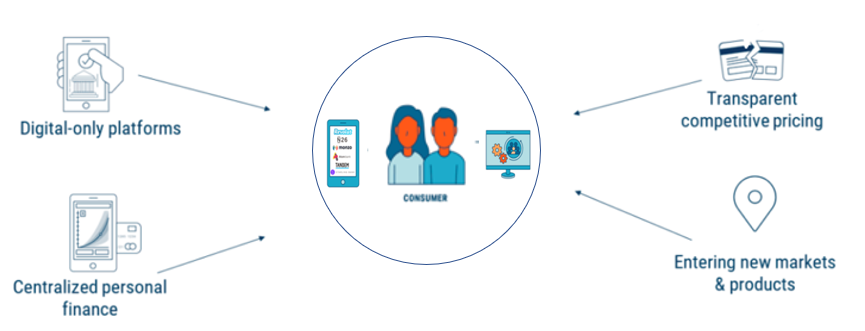Challenger Banks are Disrupting the Banking Industry with Insights-powered Digital Experiences
Banking industry has always been the leading industry to adopt technology and make significant investments. Despite making significant investments in the past they have not been able to keep up with the changing connected consumer expectations of personalized, contextual, seamless and always on experiences across different channels. Traditional banks are finding it difficult to be agile and flexible due to decade old legacy infrastructure, siloed data and product organizations and complex processes. Due to risk-averse culture at many of these traditional banks have led to no or only incremental innovation. They fail to bring new products and services using emerging technologies at speed and scale. The banking operations are inefficient, complex and not optimized to serve the new age connected consumer.
The “new kid” on the block is punching above its weight.
Taking advantage of this need to deliver seamless experience at speed, engage customers with innovate products/services across channels and using emerging technologies at the core of their business model, many new age start-ups have come up in past couple of years. They are challenging the traditional banks and are being referred as “challenger banks” and are powered by accelerated customer acquisition, funding, partners, open API and technology initiatives, product quality and customer experience. Some examples are N26 (German), Monzo, Allica, Virgin Money Digital Bank (UK), digibank by DBS, Starling Bank (US), etc.
Challenger Banks are a new breed of technology-driven and customer-centric financial institutions that are reimaging and redefining ways how customers are utilizing and interacting across the banking value chain. These banks are not any of the recognized, traditional, main high street banks (RBS, HSBC, Lloyds, Barclays, Santander), but they have been able to create lot of buzz and interest among customers, partner, VCs and traditional banks in recent years. Their core differentiator is driving innovation and improving customer service levels in the banking domain using emerging technologies.
Challenger Banks are Targeting Traditional Functional Areas
 The changing landscape of today’s digital marketplace has also affected the way in which banks are reaching customers, running their operations and protecting themselves from various risks and threats.
The changing landscape of today’s digital marketplace has also affected the way in which banks are reaching customers, running their operations and protecting themselves from various risks and threats.
Changing customer expectations, open banking, and newer regulations around data utilization are the key drivers
Customers who are receiving customized offers and instant response from other domains like Retail, E commerce, Hyper local deliveries, Food and beverage, Entertainment etc. they expect the same or even high customer service levels and personalization when it comes to their banking activities. Increased scrutiny by regulators and customers have led to new focus areas which the banks can now leverage.
The Open banking directive and PSD2 lead to collaborative efforts from banks to partner with specialized service providers who can build financial and digital marketing capabilities on top of the bank’s data and infrastructure. This allows for banks to be able to customize offers based on relationship-based pricing. The Product mix of banks today also has changed and has separated out niche, moment- based offers, behavioral financing and Life stage/Need based financial support through various products and services of the bank.
Compared to traditional banks which offer general category rates and slower response, the newer digitally focused banks can mass personalize. While in traditional banks the low customer satisfaction rates and low turnaround times leads to frustration for the customers and loyalty erosion. The challenger banks also can onboard these newly acquired customers through digital channels and robust data collection infrastructures.
Apart from the customers requirement for newer ways in which banks could service their customers, there is also a financial economic incentive for new entrants in today’s world. By choosing to play in specific areas where the bank specializes, Challenger Banks are more profitable than incumbents as they have, a smaller cost base, asset light business models, cheaper and faster IT systems.
Modern banks also need not necessarily have the same balance sheet composition as the big banks or the legacy IT baggage. Challengers have outperformed the Big Five on costs, with an average cost-to-income (CTI) ratio of 59.6 compared to 80.6 percent for the incumbents. Challenger banks that operate without a significant branch network have significantly lower costs across their customer and channel functions too. Since they can acquire funds from an alternate source of funding outside of just deposits, they have flexibility and speed which traditional banks lack to offer cheaper loan rates and higher borrowing rates.
Personalized digital experiences powered platform of intelligence is at the core of their business model
- Personalized and Seamless Digital experienceEffective personalization has been a great strength and differentiator for challenger banks. These banks have a deep understanding of the complex multichannel customer journey and experience gaps, and have the ability to quickly build a single view by collecting rich, unique data points to personalize a customer’s experience. They can provide a seamless branded experience with personalization across the value chain and at every interaction point. From choosing the right channels for acquisition and engagement and delivering 24*7 convenience for customer using intelligent and conversational services through IVA, chat bots and self-service Apps have helped drive the personalization agenda. We also see banking and financial education happening on new channels such as social media, blogs and even simulators for banking customers which allow the customer to be engaged throughout the banking process. From Emails to Ads banks, they can extract the exact needs of a customer and communicate it to the with a personalized offer which applies to his/her life stage, lifestyle and wants. These have shown to have high conversion rates and lesser churn.
- Platforms of intelligence
At the core of these challenger banks is the platform of intelligence for its customers and banking operations. The customer intelligence platform can collect the massive amounts of structured and unstructured data in a data hub/data lake construct. The data collected and stored in accessible formats is analyzed for different use cases – segmentation and personalization using AI/ML models to identify gaps, patterns, opportunities and next best actions. This was previously done in silos or were slow legacy systems. Today its an age of continuous intelligence and the insights are derived from constant analysis using advanced analytics, AI/ML algorithms and cross domain experts of the underlying data generated and consumed by the bank and its partners ecosystem. This can be analyzed for deep insights and powerful visualization, marketing automation, risk controls, funding and lending projections and optimization. The platform of intelligence for banking operation can drive operational efficiency internal to the banks in terms of risk assessment, liquidity planning, portfolio management by using advanced analytics and AI/ML algorithms to optimize various banking levers makes the internal functioning of the bank more efficient and less risky.
These challenger banks have been working with IT service providers like ITC Infotech to build these platforms of intelligence and deliver personalized, seamless experiences to its customers as well as leverage insights to drive operational efficiency across their organization.
Stay tuned for the next blog in this Challenger Bank service as we deep dive into how they are building platforms of intelligence for consumer and operations and are creating a differentiation for themselves!
Author:
Rohit Subramaniam
Lead DX Consultant and a Challenger Bank Expert, DX Practice, ITC Infotech
Recent Posts
 Enterprise Architecture Reimagined: Exploring its Facets in the AI Epoch
Enterprise Architecture Reimagined: Exploring its Facets in the AI Epoch Why organizations using DevOps tools are getting ahead of the rest
Why organizations using DevOps tools are getting ahead of the rest Generative AI: Creating the lightning rods for success (around a 3A Axis)
Generative AI: Creating the lightning rods for success (around a 3A Axis) Generative AI, a new catalyst for D2C expansion
Generative AI, a new catalyst for D2C expansion How to Maximize Business Productivity with Gen AI?
How to Maximize Business Productivity with Gen AI?






